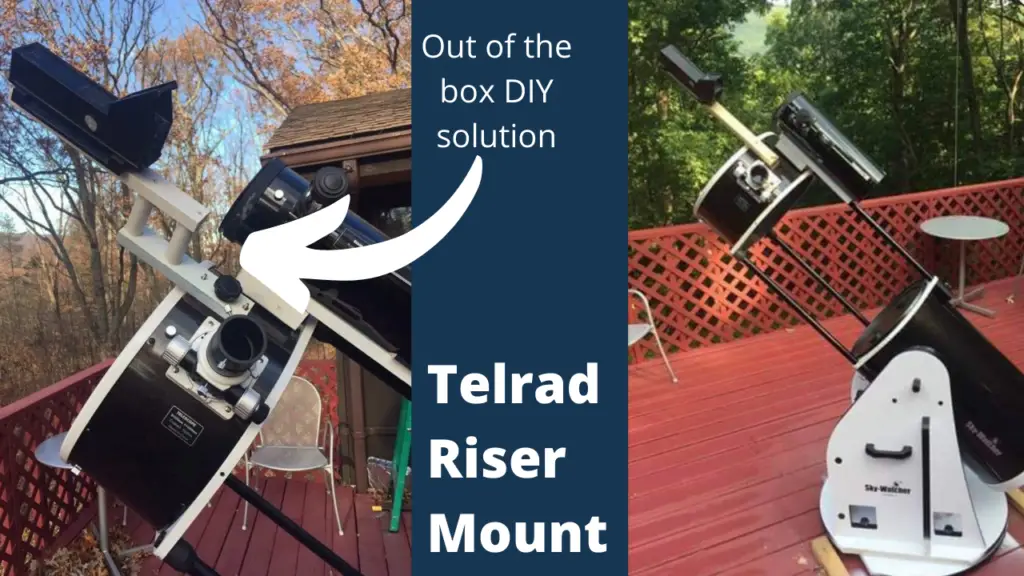A Telrad finder is a great piece of equipment for any astronomy setup. Installing it is simple and does not require any tools.
Install a telrad to the right of the focuser, next to the finderscope if one is installed. You can choose to remove the finderscope and replace it with a telrad. The telrad should be in a position that you can comfortably look through from your position at the focuser. There are telrad risers available to make the position more comfortable.
Telrads come with two long strips of 3M tape to attach the telrad to the telescope.
Consider placing the telrad with painters tape and test out the position before you firmly attach the telrad. Be sure to check how it feels when observing objects close to the zenith and close to the horizon. If you cannot find a comfortable place for the telrad, you may need a telrad riser.
Some people use a 3-D printer to print telrad risers, they can be improvised with wood or plastic, they are also available from High Point Scientific.
It is nice to have both a telrad and a finderscope, if you scope came with a finderscope, keep it installed and add a telrad. The low magnification of a finderscope is helpful at times.

Where To Install A Telrad On A Truss Tube Dobsonian
Truss tube Dobsonian telescopes can pose problems when you want to add accessories. There is less real estate for installing accessories.
I was surprised to find the the telrad fit perfectly on my upper tube assembly on my Dobsonian truss tube. It is like it was made to fit there!
If you are unhappy with the position of your telrad, there are a lot of DIY options to create extensions and risers that will put it just where you want it.
I reached out to Red Henry, an amazing astronomer and he shared these pictures of his creative set up.
How do I set up a Telrad?
Telrad finders are two pieces. The base detaches from the Telrad and it is what stays attached to the telescope. The sticky mounting tape is on the base. It is helpful to remove the Telrad when transporting the scope so it does not get bumped around.
When installing the Telrad attach it to the telescope next to the finderscope if one was installed. Find the best position for the Telrad by sitting by your scope and looking through the Telrad.
You should find a comfortable position where you do not have to move much from your position observing to see the red circles of the finderscope.
Attach the Telrad with painters tape and take it out for a night of observation. Be sure to observe objects very close to the horizon and very close to the zenith. See if you can still comfortably see through the Telrad from your position at the focuser.
There are lots of ways to mount a Telrad. I have included some off the wall solutions for finding the perfect position for observing comfortably.
Do I need a Telrad riser?
After using a telrad for a few years, I am ready to invest in a riser. They make observing much more comfortable.
Depending on the size of your scope, your observing chair, your height and your telescope mount a telrad riser may put your telrad in a more comfortable position for observations.
Telrad risers can be made at home with wood or plastic. They can be printed with a 3D printer, there are files with instructions in Astronomy facebook groups.
It can be attached to your telescope with screws or adhesive.
How do you align a telrad finder?
The telrad has three knobs that are used to adjust the position of the red circles on the glass.
The telrad is easier to align at night when you can see the illuminated red circles more clearly. Find a bright star and center it in your eyepiece. Then find the same star with your telrad and adjust the knobs until the center circle is over the bright star.
I am not very technical and this was so user friendly.
Telrads are a zero magnification device so you can look through it and you will get an idea of what you will see when you look through the eyepiece. If the telrad is not aligned with your scope it is no longer useful.
Telrads are most helpful for star hoping. It allows you to quickly scan the sky and easily find lots of objects.
I like to use my telrad finder so that when I am doing outreach I have an idea of what the observer is looking at. I can stand at the back of the telescope and look through the finder to help track the object. I can be sure that the object is still centered in the eyepiece without asking them to move so I can see through the eyepiece.
Carry a second set of batteries for your telrad in case they fail. It is possible to use your telescope without a telrad, but once you get used to using it you may not want to. I know a guy who says that if his telrad dies, he’s done for the night.





